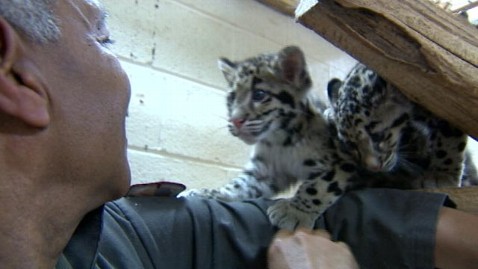Smithsonian Conservatory Rescuing Exotic Animals From Extinction

(ABC News)
When you see African cheetahs, Chinese red pandas, Micronesian kingfishers and hooded cranes, you might think you're in the wilds of Africa or Asia.
Watch a kingfisher show off fishing skills.
But in rural northern Virginia, little more than an hour from Washington, D.C., you can find all of those animals at the Smithsonian Conservation Biology Institute.
It is home to some of the most endangered animals in the world, including clouded leopards, originally from Indonesia.
The institute currently has two clouded leopard cubs, a male and a female, that are a little more than 100 days old.
The population of clouded leopards has been decimated by hunters and poachers who sell their furs. The Smithsonian has bred 80 of the magnificent cats.
"When it comes to all these animals, the one common denominator is loss of habitat," said Paul Marinari, the biology institute's senior curator.
Many of the animals at the institute enjoy a level of freedom that is rare in captivity. They are kept in large, open spaces spilling over 3,000 acres. It is a refuge in rural Virginia where some of the world's most endangered animals are being brought back from the brink of extinction.
Most of the animals come from zoos. Smithsonian researchers study to learn how to breed and rear them in captivity. Some are sent back to zoos but many animals are returned to nature.
The black-footed ferret, one of the most endangered species in North America, had been all but wiped out before a ranch dog found 18 in Wyoming. Marinari said his team captured the solitary, nocturnal animals and brought them into captivity.
"This is our 25 th year of having black-footed ferrets," he said. "They were thought to be extinct several times. … This is one species where we actually have the potential very soon to actually downlist and eventually delist them off the endangered species list."
The institute has bred and released nearly 8,000 black-footed ferrets from that first group of 18. The Smithsonian currently has month-old, baby black-footed ferrets. They, too, will be released.
"These guys could end up in Arizona. They could end up in Kansas," Marinara said. "They will be [back] in the wild."